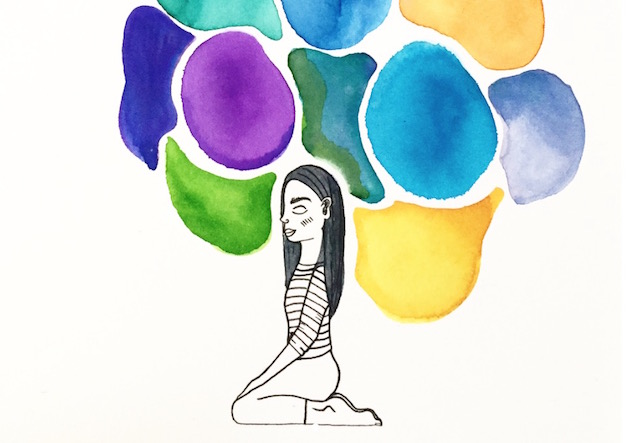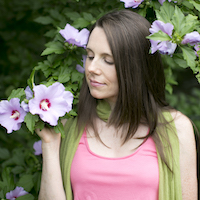I used to think that my pain meant failure.
When I felt down, anxious, depressed, or melancholic, I would try to fix it. Fixing would mean doing some kind of activity to purge my feelings—journaling, talking to someone, or doing a physical exercise to clear my head.
But one day I experienced a tragic and sudden loss. On that day, my fixing tools didn’t work. I was at a loss. What was I supposed to do with this pain?
We are a culture of doers who value schedules (Google calendar anyone?) and lists (who doesn’t have some kind of list app on their smartphone?).
Sometimes, life presents us with things that none of our tools will fix. We have nothing left to do but let life take the lead.
My tools failed when my sister died at the age of 20. In that fragile place, yoga found me.
Yoga found me months before she died, but I hadn’t yet found it. Before my sister left this planet, I spent many months attending local classes at studios. I spent hours on my mat breathing deeply as I connected with tight muscles and anxious thoughts. As a new yoga student, I found myself looking at the clock often wondering, “When would this be over?”
Yet, despite my impatience, I kept coming back.
When I lost her, the yoga studio around the corner was the first place (other than my bed) where I sought out peace and comfort. With each breath and each movement on the mat—the mat my sister gifted me—my wounded heart found a quiet sense of solace. In the presence of other students, I found a community, and I did not need to engage in mundane conversations. The presence of other minds and hearts breathing together with mine was enough to me.
When I start teaching a yoga class, I often ask students to connect to their hearts to create an intention for their practice. The heart I’m referring to is the heart center—the emotional heart. The emotional heart has a physical residence in the chakra named Anahata. It is located in the chest, upper back, and shoulders, and is governed by the heart and lungs. When we tap into our emotional heart, we connect with ourselves on a feeling level. Every emotion we experience manifests as a physical sensation in the body.
On the first anniversary of my sister Rebecca’s death, I awoke with a feeling of heaviness. It felt like a weight gripping its claws around my chest and shoulders. My family was planning a gathering that evening. Thinking of that gathering seemed to amplify the weight and it exhausted me. Seeking relief, I gazed at my mat and strap with a sense of defeat: I had no energy to practice a Hatha flow sequence.
In that moment, I remembered a restorative pose my teacher introduced me to in a private lesson. My teacher said that pose helped her after she lost her best friend. As a poor college student, I had no fancy Mexican blankets or cork blocks. Instead, I gathered the pillows and blankets that I had to make bolsters for my spine and knees. I pulled the strap over my waist with a large gap as if it was a belt made for Santa. I put one part of the strap around my lower sacrum and the other around the outside of my feet binding them together in a supported butterfly pose. My spine melted onto the thick bolster made of a pillow and a folded blanket.
As I lay back with my arms outstretched, I closed my eyes and took a deep breath. In the space of 20 minutes or so, I melted—my whole self melted. The support of these props was taking away my burdens. In that moment, my breathing shifted and deepened. In that space, a wave of joy washed through my emotional heart.
Suddenly, I was not grieving the loss of my sister. Suddenly, I was completely immersed in the present moment—breathing and being in the peace and stillness of being here now.
Before she left this earth, my sister’s motto was: be here now (in reference to Ram Dass).
In essence, be here now is the teaching of yoga. With each breath we pay attention to, we embody the moment that allows the wandering mind and the suffering heart to find a place in stillness.
In that stillness, we tap into a deep peace. The peace that we find on the mat carries us gracefully off the mat and stays with us as we walk into our everyday lives. One day, we may find ourselves stuck in a traffic jam or washing dishes in our kitchen. Suddenly, we pay attention to our breath and the sensations in our body. We feel a sense of stillness with it all. On that day, we see that yoga is not just an on the mat practice but a way to live our life with an open heart and a clear seeing mind. On that day, we see that the broken pieces of ourselves didn’t break us down, but broke us open, allowing us to surrender more fully to this life.
Each breath on or off the mat offers us a space to be fully here, fully now—accepting whatever in the moment. This practice still stays with me. It’s a reminder that we can find bliss in our pain—and that we can find sadness in our joy.
All possibilities exist at any given moment. What yoga offers us is a place to come home to—a place to give up the fight and embrace beauty.
This life, it’s so very sacred. Your breath, it’s your gateway to its sacredness.
A breathing pause:
Pause for just a moment and take a deep breath with me. Feel that air rush into your nostrils and savor it for a moment at the top of the inhale. Take a little pause. Then let it go and notice how your body responds to the release. Then do it again a few more times.
This life, it’s so very sacred. Your breath, it’s your gateway to its sacredness.
Savor it.
Savor it all—the long cool inhales, the silent pauses, and the slow warm exhales.
This life, it’s so very sacred.
I’m so grateful for the teaching moments that our great suffering offers as, without them, we wouldn’t know our own wholeness.
~
Author: Sarah Lamb
Image: @Christie Creative on Instagram
Editor: Angel Lebailly
Copy Editor: Khara-Jade Warren
Social Editor: Khara-Jade Warren











Read 5 comments and reply